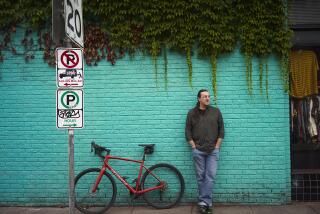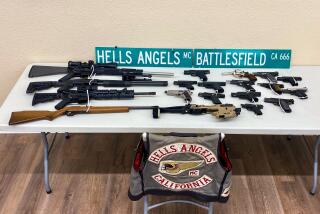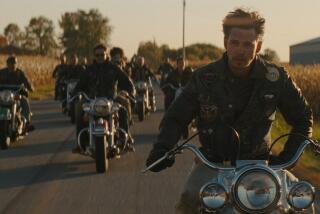Bikers Feud in Land of the Vikings
- Share via
HASSLARP, Sweden — Siv Persson passed through this tiny farm town with the wariness of a lost motorist in a tough city neighborhood.
“You’ll understand if I don’t stop or slow down,” she said, hurriedly turning her two-door Ford past the old fish market. “It is not a good idea.”
Persson isn’t just a passerby; she is the local representative to the Swedish legislature. The fish market no longer sells seafood; it serves up a saucy chapter of the Oakland-based Hells Angels.
And for months now, the lawmaker and the outlaw bikers--enemies to the core--have known no peace because of a bloody motorcycle war that is barreling across Scandinavia. The combat pits home-grown copycats of America’s most infamous biker gang against a local version of one of the Angels’ chief rivals, the Houston-based Bandidos.
The problem is straightforward: The Angels and the newly arrived Bandidos have determined that the land of the midnight sun isn’t big enough for both of them. And in just the past three months, police say, four gang members have died to prove it.
Facing death threats from unnamed bikers herself, Persson keeps in her pocketbook a fire-engine-red cellular phone that can transmit an alarm to police in seconds. Her mail is screened for explosives. She can’t even accept a bouquet of flowers without a security officer first picking through it.
Their lives also on the line, albeit for other reasons, the Hells Angels in Hasslarp dwell like caged animals behind a tall fence topped with barbed wire. Rooftop surveillance cameras scope goings-on. Scaffolding surrounds most of the clubhouse, which has a hole the size of several watermelons blown through an upstairs wall.
“We don’t talk to the press, man,” an Angel with a bushy ponytail and black leather jacket told a reporter, suspiciously poking his head outside a metal gate plastered with a guard-dog warning. A second inquiry was rebuffed with a silent stare and a slammed door.
Twice since last summer, antitank missiles have pummeled the rural compound, fired by rival bikers holed up in a dairy farm-turned-fortress less than two miles down the road. The Bandidos, who police say heisted the weapons from a Swedish military depot, narrowly missed a neighboring house with children inside in one of the assaults.
“This is such a nice part of the country, where people live because it is--or should I say was--such a good place to be,” said Persson, public enemy No. 1 among bikers because she has campaigned to rid Sweden of them. “Now you mention this place and people say, ‘Oh yes, it’s so nice there, but how are the shootings today?’ ”
This pastoral Scandinavian setting is indeed a peculiar battlefield, but it is not alone and it is not the first. The last motorcycle war in Scandinavia was fought only a decade ago in Denmark, where the region’s gangs first gained prominence in the 1970s. Murderous turf wars have been waged from France to Canada.
*
This time, Scandinavia’s biker front line extends through towns, big and small, from Denmark to Finland, stretching into new nooks and crannies as fast as an unmuffled Harley-Davidson can thunder by.
The combatants are local hooligans, outcasts and crooks who act out a rivalry born decades ago and thousands of miles away in California and Texas. In keeping with biker feuds elsewhere in the world, their arsenal includes grenades, assault rifles and missiles built for tank-to-tank warfare.
There have been shootouts at the Copenhagen and Oslo airports, missile raids on clubhouses here and in Denmark, a grenade attack at a Copenhagen prison and more than 20 drive-by shootings and car bombings in towns sprinkled below the Arctic Circle.
Police say the two gangs are backed by a large cadre of surrogates, wannabe club members known as “prospects” and “hang-arounds” who often prove themselves through outrageous behavior.
Authorities estimate that there are 1,000 outlaw bikers in Scandinavia, but the Hells Angels and Bandidos chapters themselves are highly selective. In Denmark, where both clubs have the deepest roots, their combined membership is under 100, and the numbers are smaller in Sweden, Norway and Finland, police say.
Even so, it is clear only one gang can stay, said Dag Gardare, a Stockholm police detective assigned to motorcycle gang crime.
“It is not like in the United States, where it is big enough to have the Hells Angels in California and the Bandidos in Texas,” Gardare said. “Here they are right on top of each other, like nowhere else in the world.”
Ostensibly, the deadly duel is about biker supremacy and was set off, according to one version, by an insulting barroom brawl in Denmark across the Oresund strait.
As the story goes, a desperate Hells Angel locked himself in the women’s restroom to escape a carousing gang of Bandidos. That humbling episode--or perhaps one or many like it, since no one can say for certain--grew into a deadly tit-for-tat over biker honor and shame.
“There is a constant competition for gaining honor,” said Joi Bay, a Copenhagen University sociologist who has spent time with the gangs. “The problem is that the only way to achieve honor is to steal it from another man, and that often leads to violence.”
While better known for Hans Christian Andersen and Santa Claus, the Scandinavian countries are no strangers to motorcycle brutality. Scandinavians, Bay said, have never lived up to the placid fairy-tale image so often depicted in books and the news media.
In the early 1980s, more than a dozen bikers were killed in Denmark in a feud between the Hells Angels, then newly arrived in the region, and a local gang. The Angels won that fight--the other gang ceased to exist--but defeated bikers found their way into other clubs, including some that recently became Bandidos chapters.
“There is a generational change going on, and the young prospects don’t like sitting around the clubhouse listening to stories about killings from the past,” said Ambro Kragh, a Danish journalist who has covered the gangs for 10 years and has written two books about them. “They want to get out and do some of their own.”
The new wave of violence comes even as the old one continues to resonate. The best-known Hells Angel in Scandinavia is Jorn “Jonke” Nielsen, who is serving the final years of a prison term for killing the leader of a rival gang in 1985.
Oddly enough, Nielsen also is a best-selling author, popular speaker on the Danish lecture circuit and a hero among some young people.
“They see him as the prototype of the honorable biker,” Bay said. “After the killing, he fled to Canada but then turned himself in. He humiliated the police, then accepted his fate as a man.”
*
As a well-behaved inmate in a minimum-security institution, Nielsen ventures into the outside world from time to time. His supervised trips bring him to schools and talk shows, sometimes for pay. He has a telephone and fax in his cell. Under the Danish system, Nielsen and many other prisoners are allowed such freedoms to prepare themselves for life on the outside. Once released, they are billed by the state for the cost of their stay.
In the decade since his crime, the convicted murderer almost single-handedly rehabilitated the image of Denmark’s Hells Angels. He says they are neither criminals nor violent.
Nielsen, not coincidentally, has slipped into obscurity since the killing started anew. Police say both clubs have issued gag orders to members since publicity has brought unwanted scrutiny and may have fueled the conflict. Kragh said the damage caused by the violence may be too great for even the master salesman to repair.
“They were golden. They were being taken seriously by the politicians and the media,” Kragh said of the Hells Angels. “Now they have shot themselves in the foot.”
Police say it is far too early to speak about damage control anyway. The latest round of violence is only beginning, they predict, in part because the contest seems to carry greater spoils than any previous conflict.
Although they offer no direct evidence, authorities believe the war has a strong criminal element. With the collapse of communism in Eastern Europe, Scandinavia has become the gateway to a thriving underworld in the former Soviet Bloc, and police say the outlaw bikers want a piece of the action.
Individual bikers in Scandinavia have been known to run sophisticated rings involved in drugs, prostitution, arms smuggling and other illegal activities. The struggle now, police suspect, is for a little-mentioned peace dividend of the Cold War: access to the vast criminal East, including its flourishing mafias.
“This isn’t about motorcycles--it is about power, territory and the criminal market,” said Gardare, the Stockholm detective. “They usually travel by car or limousine, and 60% of them don’t even have driver’s licenses for motorcycles. Many of them were criminals before they joined these clubs, and they remain criminals.”
Police have strong suspicions, but no proof, that the dozen or so Scandinavian chapters of the two outlaw clubs are beginning to act as organized criminal enterprises, much like their parent organizations have done in the United States.
Danish police say more than half of the Hells Angels and Bandidos are known criminals, and that has been enough for courts and legislators in Denmark and Sweden to authorize a crackdown on outlaw bikers. A 1994 report by the European Union said Denmark’s 120 motorcycle gangs dominate organized crime in the country.
Since the killing started in March, authorities have routinely pulled over bikers and raided clubhouses, checking for weapons and drugs. They also monitor the comings and goings of some chapters. But police have been unable to cool the feud, and they acknowledge that they are helpless to prevent public shootouts such as the March 10 ambush in a Copenhagen airport parking lot that killed a Danish Bandidos leader and wounded two others.
Police arrested six bikers in that attack, but it is unclear what fate awaits them. Throughout Scandinavia, frightened witnesses are seldom willing to testify in biker cases, and the bikers themselves do not cooperate with police investigations.
“This is all very unusual for us,” said Mogens Sorensen, who heads the motorcycle gang intelligence unit of the Danish National Police. “We don’t see many homicides here [in Denmark], maybe 50 or 60 a year. I am concerned, the police are concerned, and the entire society takes it very seriously.”
But residents in Hasslarp complain that the police are doing too little to win back their town of 600 families about 300 miles southwest of Stockholm on the coastal flatlands of southern Sweden.
If it weren’t for Persson, the legislator, they would have virtually no voice, they say. Even local leaders keep a careful distance.
“She’s one tough lady,” said a middle-aged man, who like other residents asked not to be identified. “I don’t think anyone else dares to even talk to them.”
It has always been awkward living alongside the bikers, the man said, but for a long time it was tolerable. When they first arrived five years ago, the bikers were a prospect chapter of the Hells Angels known as the Rebels. People saw them as just kids, perhaps troubled and unconventional, who liked motorcycles.
“If you didn’t bother them, they didn’t bother you,” the man said.
But relations have grown strained since September, when the first missile struck the clubhouse in a predawn attack. Police believe it was fired from an idled sugar beet processing plant across the street, where almost everyone here worked until it closed several years ago.
Bikers still don’t bother local residents, but they also do nothing to make life bearable, the residents said. The clubhouse’s heavy fortification is frightening in a town where doors are left unlocked during the day. Parents also are at wit’s end because the town playground is just down the street.
“It has gotten to the point where you cannot sell your house,” said a mother of two children. “Nobody will live here.”
*
Persson has hosted two meetings with bikers at a college in nearby Lund, has pushed parliament for tougher criminal penalties for motorcycle crimes and has tried unsuccessfully to win more money for local law enforcement. She also has waged a one-woman publicity campaign against the outlaw clubs, spreading the word that they must be stopped.
“I am not interested in what these people look like, what they drive or how they live, so long as it is within the law,” Persson said. “But when they live outside the law, I have told them, ‘As long as I live, I will make it impossible for you.’ ”
Residents here said they are grateful to Persson but doubtful one woman, no matter how determined, can prevail against an entire subculture. With just two options--move or look the other way--residents said the choice sadly has been made for them.
More to Read
Sign up for Essential California
The most important California stories and recommendations in your inbox every morning.
You may occasionally receive promotional content from the Los Angeles Times.










